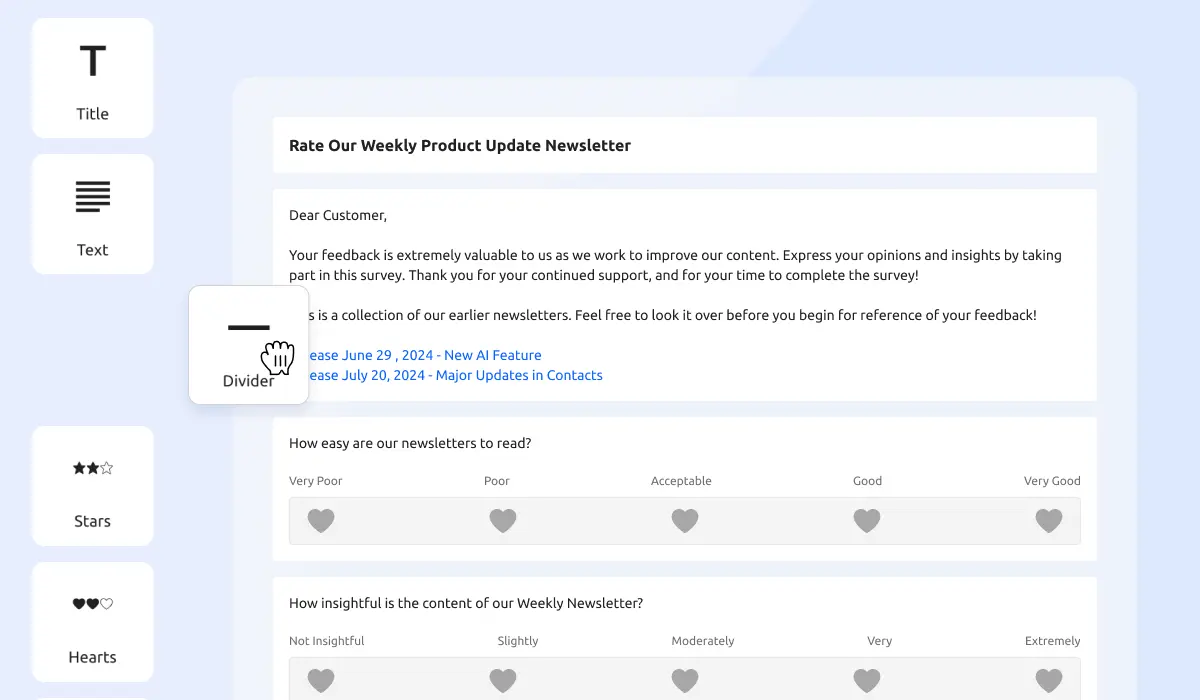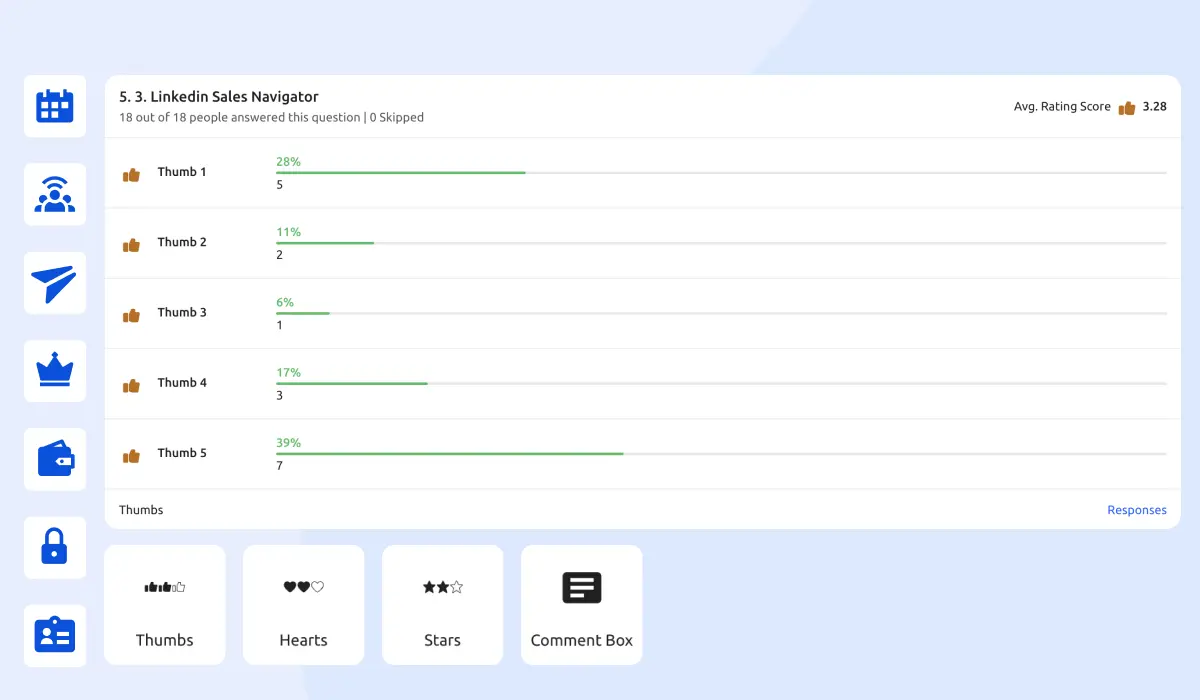
Conducting member surveys is an essential aspect of gaining insights from your association's diverse membership.
By asking relevant questions and analyzing the answers, you can collect valuable information about your members' preferences, beliefs, characteristics, and other related data. Surveys are the most effective way to gather this information, whether you use them as a one-time tool or repeatedly to track changes over time.
In this article, we'll guide you through the seven key steps of conducting effective member surveys, providing you with the knowledge and best practices to successfully carry out this research, even if you're a beginner. We'll also discuss how Glue Up's Association Management Software (AMS) can simplify the survey creation process and provide advantages over basic survey tools.
Key Takeaways
- Define clear survey objectives and goals aligned with your association's needs to ensure every question serves a purpose and leads to actionable insights.
- Identify the right target audience for your survey, focusing on a representative sample that reflects the diversity of your membership.
- Craft effective survey questions using a mix of open-ended and closed-ended questions, clear phrasing, and a logical order to gather valuable feedback.
- Choose the optimal timing and distribution channels to maximize response rates, considering factors such as survey topic relevance and member availability.
- Analyze survey results using quantitative and qualitative techniques, and close the feedback loop by communicating findings and planned actions back to your membership.
- Bonus takeaway: Simplify the member survey process and boost effectiveness by leveraging an Association Management Software like Glue Up, which offers advanced features and integrations tailored for associations.
Step 1: Define Clear Survey Objectives and Goals

Before you start creating your member survey, it's important to establish clear objectives and goals. Ask yourself and your team what you want to achieve by conducting the survey. Some common objectives for associations include:
- Measuring member satisfaction with programs, events, and services
- Identifying areas for improvement in member engagement and retention
- Validating demand for new initiatives or offerings
- Gathering demographic data to better understand your membership
By defining specific goals, you can ensure that every question in your survey serves a purpose and leads you closer to the desired outcomes. Clear objectives also help you determine the appropriate target audience for your survey.
Step 2: Identify Your Target Audience
The next crucial step is to identify the right participants for your member survey.
Consider who can provide the most relevant and valuable insights based on your survey objectives. Your target audience may include:
- All active members of your association
- Specific member segments (e.g., new members, long-time members, committee members)
- Members in a particular geographic region or industry
- Lapsed or inactive members (to understand reasons for disengagement)
While surveying your entire membership may seem ideal, it's often impractical. Instead, focus on selecting a representative sample that reflects the diversity of your membership.
The larger and more representative your sample, the more accurate and meaningful your survey results will be.
Step 3: Craft Effective Survey Questions
The success of your survey depends on how effective your questions are: When designing your member survey, consider the following factors:
Question Types
Use a mix of open-ended and closed-ended questions to gather both qualitative and quantitative data. Closed-ended questions (e.g., multiple-choice, rating scales) provide structured responses that are easier to analyze.
Open-ended questions allow members to share detailed feedback and insights in their own words.
Question Content
Ensure that each question is directly relevant to your survey objectives and provides the necessary context for accurate responses.
Avoid asking for information that you already have in your member database or CRM.
Question Phrasing
Keep your questions simple, clear, and free from ambiguity. Avoid leading questions or double negatives that may confuse respondents or bias their answers.
Question Order

Start with simple, closed-ended questions to engage respondents and encourage them to continue. Place more complex or open-ended questions towards the end. Group related questions together for a logical flow.
Glue Up's AMS offers an intuitive drag-and-drop survey builder that makes it easy to create professional-looking surveys with various question types. The AI Copilot also generates complete survey descriptions, which saves significant time compared to writing them manually.
You can also analyze the responses of previous surveys to skip irrelevant questions, improving the survey experience for your members.
Step 4: Choose the Right Timing and Distribution Channels
Timing plays a significant role in the success of your member survey. Consider the following factors when deciding when to send your survey:
Survey Topic Relevance
If your survey is related to a recent event, program, or interaction, so send it out promptly while the experience is still fresh in your members' minds.
Member Availability
Analyze your members' engagement patterns to identify the best times when they are most likely to respond. Avoid sending surveys during busy periods or holidays.
Once you've determined the optimal timing, select the appropriate distribution channels to reach your target audience. Options may include:
- Email invitations with personalized survey links
- In-app notifications or pop-ups within your member portal
- Social media posts or targeted ads
- Text messages (for short surveys)
Glue Up's all-in-one software also has email marketing tools, allowing you to send targeted survey invitations and reminders to specific member segments. You can also embed surveys directly within your member portal for a seamless user experience.
Step 5: Monitor Response Rates and Send Reminders
After distributing your member survey, keep a close eye on the response rates. Your final sample size will depend on how many members complete the survey. To boost response rates, consider the following strategies:
- Offer incentives such as gift cards, discounts, or exclusive content for completing the survey
- Send personalized email reminders to non-respondents at regular intervals
- Emphasize the importance of member feedback and how it will be used to drive improvements
- Keep the survey relatively short and communicate the estimated completion time upfront
You can also use Glue Up's AMS to get real-time insights into survey response rates, making it easy to track progress and adjust your strategies as needed.
Step 6: Analyze Survey Results and Extract Key Insights

Once you've collected sufficient responses, it's time to analyze the data and extract meaningful insights. Start by cleaning the data to remove incomplete or invalid responses. Then, use a combination of quantitative and qualitative analysis techniques:
Quantitative Analysis
- Use charts, graphs, and visual aids to identify trends and patterns in closed-ended responses
- Segment results by member demographics, membership tenure, or other relevant criteria
- Calculate key metrics such as satisfaction scores, Net Promoter Score (NPS), or engagement levels
Qualitative Analysis
- Review open-ended responses to identify common themes, sentiments, or specific feedback
- Use word clouds or text analysis tools to visualize frequently mentioned topics or keywords
- Highlight notable quotes or testimonials that provide deeper insights
Step 7: Take Action on Survey Insights and Close the Feedback Loop
The ultimate goal of conducting a member survey is to drive meaningful improvements and demonstrate the value of member feedback.
Use the insights gained from your survey to:
- Identify areas for improvement in programs, services, or member experiences
- Inform strategic planning and decision-making at the board or committee level
- Develop targeted initiatives to address specific member needs or concerns
- Communicate survey results and planned actions back to your membership
Closing the feedback loop is crucial for building trust and encouraging future survey participation. Share a summary of key findings, acknowledge common themes or concerns, and outline specific steps your association will take to address them.
Simplify Member Surveys with Glue Up's Association Management Software
While basic survey tools can help you create and distribute surveys, they often lack the advanced features and integrations needed for effective member feedback management.
Glue Up's Association Management Software offers a comprehensive solution that simplifies the entire survey process, from creation to analysis and action.
With Glue Up's AMS, you can:
- Create professional surveys with a user-friendly drag-and-drop builder
- Leverage pre-built survey templates tailored for associations
- Target specific member segments with customized survey invitations
- Embed surveys seamlessly within your member portal or emails
- Analyze results and generate visual reports with built-in analytics tools
- Integrate survey data with your member database for a holistic view of engagement
Conducting effective member surveys is a powerful way to gather valuable insights, drive improvements, and demonstrate the value of your association to your members.
By following these 7 steps and leveraging the right tools, such as Glue Up's Association Management Software, you can streamline the survey process, boost response rates, and turn member feedback into actionable results.
Ready to take your member surveys to the next level? Get a demo of Glue Up's AMS today and see how our powerful features can help you create effective surveys, analyze results, and drive member engagement.



